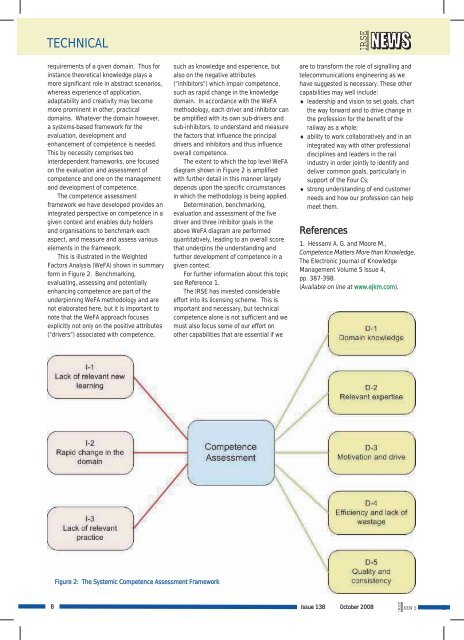IRSE News 138 Oct 08.pdf
IRSE News 138 Oct 08.pdf
IRSE News 138 Oct 08.pdf
You also want an ePaper? Increase the reach of your titles
YUMPU automatically turns print PDFs into web optimized ePapers that Google loves.
TECHNICAL<br />
<strong>IRSE</strong><br />
requirements of a given domain. Thus for<br />
instance theoretical knowledge plays a<br />
more significant role in abstract scenarios,<br />
whereas experience of application,<br />
adaptability and creativity may become<br />
more prominent in other, practical<br />
domains. Whatever the domain however,<br />
a systems-based framework for the<br />
evaluation, development and<br />
enhancement of competence is needed.<br />
This by necessity comprises two<br />
interdependent frameworks, one focused<br />
on the evaluation and assessment of<br />
competence and one on the management<br />
and development of competence.<br />
The competence assessment<br />
framework we have developed provides an<br />
integrated perspective on competence in a<br />
given context and enables duty holders<br />
and organisations to benchmark each<br />
aspect, and measure and assess various<br />
elements in the framework.<br />
This is illustrated in the Weighted<br />
Factors Analysis (WeFA) shown in summary<br />
form in Figure 2. Benchmarking,<br />
evaluating, assessing and potentially<br />
enhancing competence are part of the<br />
underpinning WeFA methodology and are<br />
not elaborated here, but it is important to<br />
note that the WeFA approach focuses<br />
explicitly not only on the positive attributes<br />
(“drivers”) associated with competence,<br />
such as knowledge and experience, but<br />
also on the negative attributes<br />
(“inhibitors”) which impair competence,<br />
such as rapid change in the knowledge<br />
domain. In accordance with the WeFA<br />
methodology, each driver and inhibitor can<br />
be amplified with its own sub-drivers and<br />
sub-inhibitors, to understand and measure<br />
the factors that influence the principal<br />
drivers and inhibitors and thus influence<br />
overall competence.<br />
The extent to which the top level WeFA<br />
diagram shown in Figure 2 is amplified<br />
with further detail in this manner largely<br />
depends upon the specific circumstances<br />
in which the methodology is being applied.<br />
Determination, benchmarking,<br />
evaluation and assessment of the five<br />
driver and three inhibitor goals in the<br />
above WeFA diagram are performed<br />
quantitatively, leading to an overall score<br />
that underpins the understanding and<br />
further development of competence in a<br />
given context.<br />
For further information about this topic<br />
see Reference 1.<br />
The <strong>IRSE</strong> has invested considerable<br />
effort into its licensing scheme. This is<br />
important and necessary, but technical<br />
competence alone is not sufficient and we<br />
must also focus some of our effort on<br />
other capabilities that are essential if we<br />
are to transform the role of signalling and<br />
telecommunications engineering as we<br />
have suggested is necessary. These other<br />
capabilities may well include:<br />
leadership and vision to set goals, chart<br />
the way forward and to drive change in<br />
the profession for the benefit of the<br />
railway as a whole;<br />
ability to work collaboratively and in an<br />
integrated way with other professional<br />
disciplines and leaders in the rail<br />
industry in order jointly to identify and<br />
deliver common goals, particularly in<br />
support of the Four Cs;<br />
strong understanding of end customer<br />
needs and how our profession can help<br />
meet them.<br />
References<br />
1. Hessami A. G. and Moore M.,<br />
Competence Matters More than Knowledge,<br />
The Electronic Journal of Knowledge<br />
Management Volume 5 Issue 4,<br />
pp. 387-398.<br />
(Available on line at www.ejkm.com).<br />
Figure 2: The Systemic Competence Assessment Framework<br />
8<br />
Issue <strong>138</strong> <strong>Oct</strong>ober 2008<br />
<strong>IRSE</strong><br />
NEWS

















